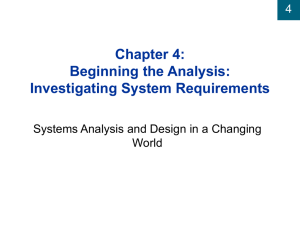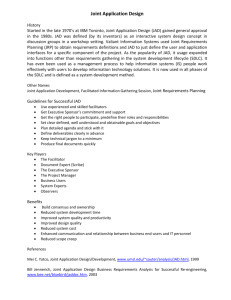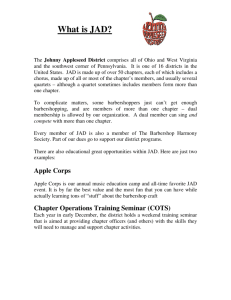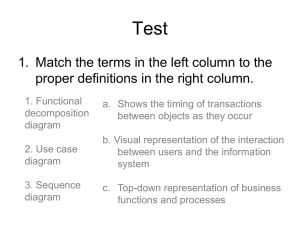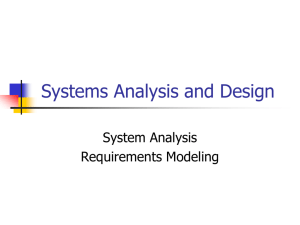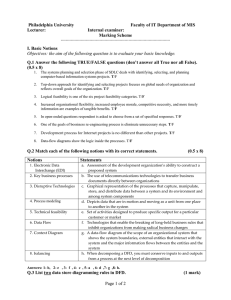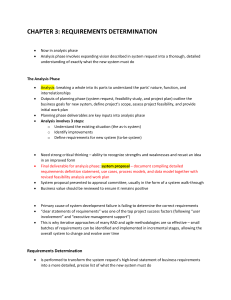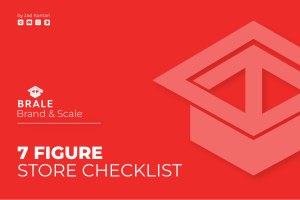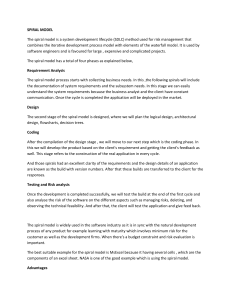Requirements Determination (Analysis) Lecture 3 1
advertisement
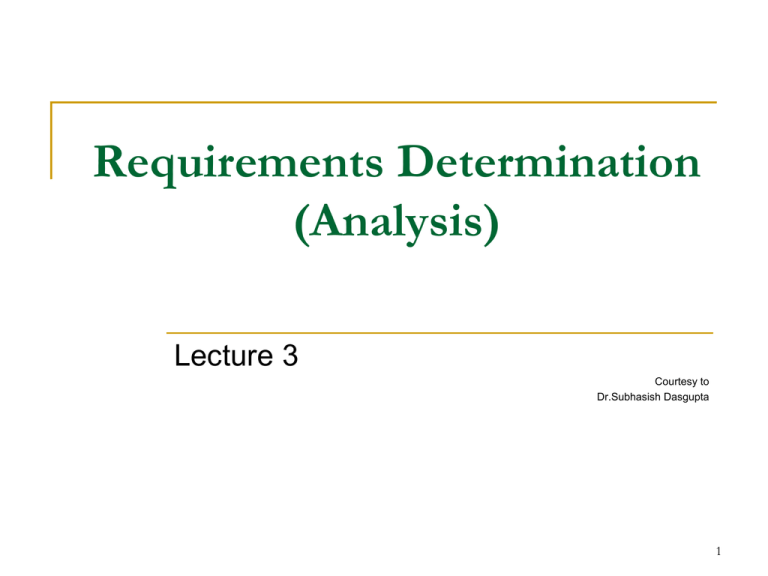
Requirements Determination (Analysis) Lecture 3 Courtesy to Dr.Subhasish Dasgupta 1 The Analysis Phase 2 Activities of the Analysis Phase and Key Questions 3 Requirement A requirement is simply a statement of what the system must do or what characteristics it must have 4 Functional and Technical Requirements System requirements – all capabilities and constraints Functional requirements Activities the system must perform Based on procedures and business functions Documented in analysis models Nonfunctional or Technical requirements Describes operating environment or performance objectives Documented in narrative descriptions of technical requirements 5 Stakeholders People with interest in system success Three primary groups Users (use system) Clients (pay for system) Technical staff (ensure system operation) 6 Users as Stakeholders User roles Horizontal - information flow across departments Vertical - information needs of clerical staff, middle management, and senior executives Business users Information users Management users Executive users External users Client stakeholders Technical stakeholders 7 Techniques for Information Gathering Objective of analysis phase is to understand business functions and develop requirements Original approach involved modeling of existing system Current approach involves identifying logical requirements for new system 8 Information Gathering and Model Building 9 Themes for Information-Gathering Questions Theme Questions to users What are the business operations and processes? What do you do? How should those operations be performed? How do you do it? What steps do you follow? What information is needed to perform those operations What information do you use? What forms or reports do you use? 10 Fact Finding Methods Review existing reports, forms, and procedure descriptions Conduct interviews and discussion with users Observe and document business processes Build prototypes Distribute and collect questionnaires Conduct JAD sessions Research vendor solutions 11 Review Existing Reports, Forms, and Procedure Descriptions First technique in fact-finding Purposes Preliminary understanding of processes Guidelines / visual cues to guide interviews Identify business rules, discrepancies, and redundancies Be cautious of outdated material 12 Conduct Interviews and Discussions with Users Most effective way to understand business functions and rules Time-consuming and resource-expensive May require multiple sessions 13 Observe and Document Business Processes From office walkthrough to performing actual tasks May make users nervous Not necessary to observe all processes at same level of detail May be documented with workflow diagrams 14 Characteristics of Prototypes Preliminary working model of a larger system Operative Focused Working model Accomplishes single objective Quick Can be built and modified rapidly 15 Distribute and Collect Questionnaires Limited and specific information from a large number of stakeholders Preliminary insight Not well suited for gathering detailed information Open-ended questions vs. close-ended questions 16 JAD Sessions Used to expedite the investigation of systems requirements Seeks to compress fact-finding, modeling, policy formation, and verification activities into a shorter time frame Critical factor is to have all important stakeholders present 17 JAD Participants JAD session leader Users Technical staff Project team members 18 JAD Facilities Generally conducted in special room Limits interruptions May be off-site Resources Overhead projector, white board, flip charts, and work material Electronic support CASE Tools Group support systems 19 High-Tech JAD Facility 20 Research Vendor Solutions Many problems have been solved by other companies Positive contributions of vendor solutions Provide new ideas May be state of the art Cheaper and less risky Danger May purchase solution without understanding problem fully 21 Techniques in Vendor Research Demo or trial system References of existing clients On-site visits Printout of screens and reports 22 Business Process Reengineering Questions basic assumptions Provides radical improvements IT often used as integral part of BPR System development project may include components of BPR 23 Validating Requirements Make sure gathered information is correct Structured walkthrough Effective means of implementing quality control early in project Verify and validate system requirements Review of findings from investigation and of models based on findings 24 Business Process Reengineering Questions basic assumptions for doing business and seeks to find a better way Uses IT as an enabler Systems analyst may discover opportunities for business process improvement 25
